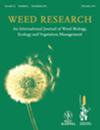Bi‐directional hoeing in maize
IF 2.2
3区 农林科学
Q2 AGRONOMY
引用次数: 0
Abstract
Abstract The weed control efficacy (WCE) of mechanical weeding in the inter‐row area in conventional cropping systems can achieve more than 90%. Despite the use of special intra‐row tools (e.g., finger weeders), only a WCE of 65%–75% can currently be realized in the intra‐row area. To close the gap between inter‐row and intra‐row WCE, in this study, a new approach for high‐efficacy precise mechanical weeding is presented. By using a GPS‐based pneumatic precision seeder (Kverneland GEOseed), a square crop seeding pattern of 37.5 cm × 37.5 cm was established in maize to enable post‐emergence hoeing lengthwise and transverse to the sowing direction. Thus, the treated area by the hoeing blades is postulated to increase, resulting in higher WCE. For this, six field experiments were conducted in South‐Western Germany in 2021 and 2022. Goosefoot blades and no‐till sweeps were guided automatically using a camera for row detection and a hydraulic side‐shift control for the hoe. This bi‐directional treatment was compared to an herbicide application and to hoeing treatments only along and transverse to the sowing direction. The bi‐directional hoeing treatment increased the WCE compared to hoeing along the crop rows on average from 80% to 95% and was not significantly different from the herbicide applications in 2022. Precise sowing in combination with hoeing along and transverse the crop rows resulted in 5.3% crop losses compared to 2.2% for hoeing only along the sowing direction by using only 15 cm wide goosefoot blades, while in the herbicide treatment and the untreated control no crop losses were detected. While maize biomass was not significantly different from the herbicide treatment in most cases over both years, in 2022, even the grain yield of the bi‐directional hoeing treatment with goosefoot blades (7.8 Mg ha −1 ) was statistically equal to the herbicide treatment (6.9 Mg ha −1 ). This study demonstrates the great potential of bi‐directional hoeing as an effective alternative to chemical weed control in row crops such as maize, sunflower and sugar beet.玉米的双向锄地
摘要在常规种植制度下,行间区机械除草防草效果可达90%以上。尽管使用了特殊的行内工具(例如手指除草器),但目前在行内区域只能实现65%-75%的WCE。为了缩小行间和行内WCE之间的差距,本研究提出了一种高效精密机械除草的新方法。利用基于GPS的气动精密播种机(Kverneland GEOseed),在玉米上建立了37.5 cm × 37.5 cm的方形作物播种模式,以便在播种方向纵向和横向进行苗后锄地。因此,假定锄地刀片的处理面积增加,导致更高的WCE。为此,2021年和2022年在德国西南部进行了六次实地试验。使用相机进行行检测和液压侧移控制锄头,可以自动引导鹅脚叶片和免耕扫扫。这种双向处理与除草剂施用和仅沿播种方向和横向的锄地处理进行了比较。与沿作物行锄地相比,双向锄地使WCE平均提高了80%至95%,与2022年除草剂的施用没有显著差异。精确播种与沿作物行和横向锄地相结合导致5.3%的作物损失,而仅使用15厘米宽的鹅足叶片沿播种方向锄地的作物损失为2.2%,而在除草剂处理和未处理的对照中未检测到作物损失。虽然在这两年的大多数情况下,玉米生物量与除草剂处理没有显著差异,但在2022年,即使是鹅足叶片双向锄地处理(7.8 Mg ha - 1)的谷物产量也与除草剂处理(6.9 Mg ha - 1)在统计学上相等。本研究表明双向锄头作为化学除草的有效替代方法在玉米、向日葵和甜菜等行栽作物中具有巨大的潜力。
本文章由计算机程序翻译,如有差异,请以英文原文为准。
求助全文
约1分钟内获得全文
求助全文
来源期刊

Weed Research
农林科学-农艺学
CiteScore
4.30
自引率
0.00%
发文量
41
审稿时长
12-24 weeks
期刊介绍:
Weed Research is an international peer-reviewed journal that publishes topical and innovative papers on weed science, in the English language. Its aim is to publish the best weed science from around the globe and to be the journal of choice for weed science researchers. It is the official journal of the European Weed Research Society. Papers are taken on all aspects of weeds, defined as plants that impact adversely on economic, aesthetic or environmental aspects of any system. Topics include, amongst others, weed biology and control, herbicides, invasive plant species in all environments, population and spatial biology, modelling, genetics, biodiversity and parasitic plants. The journal welcomes submissions on work carried out in any part of the world.
 求助内容:
求助内容: 应助结果提醒方式:
应助结果提醒方式:


